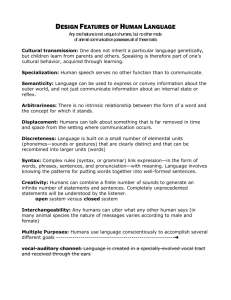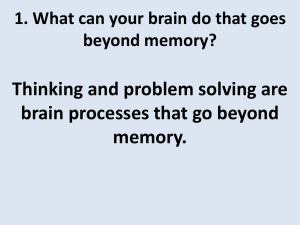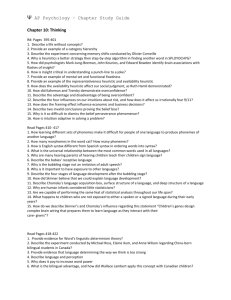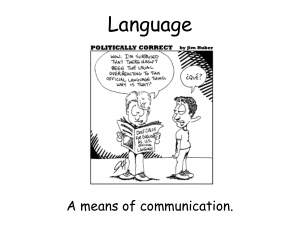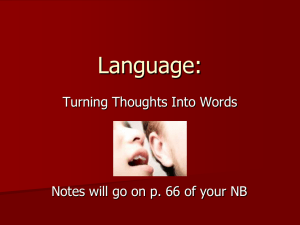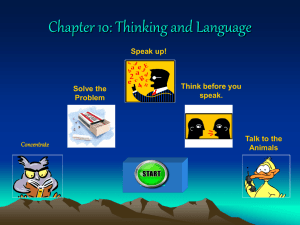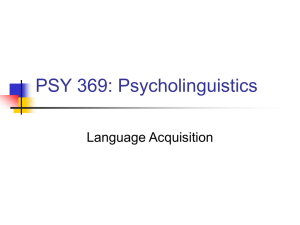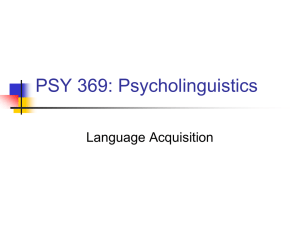Language and Thought Notes
advertisement
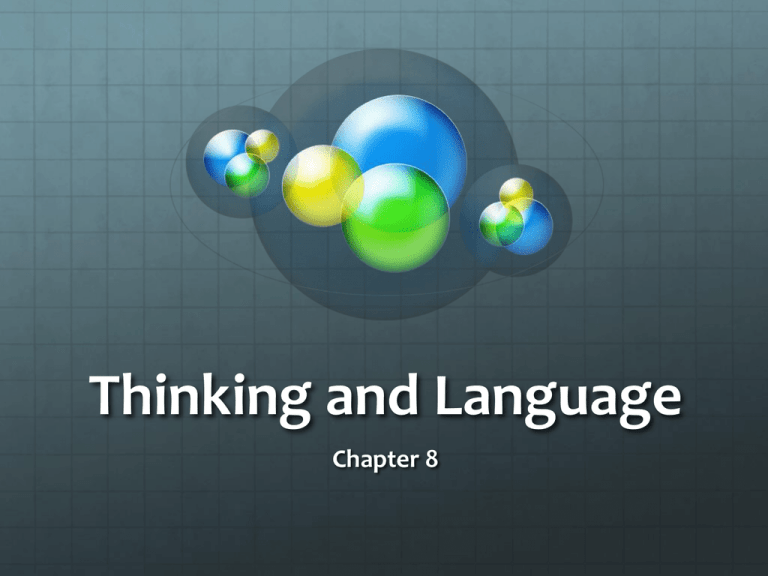
Thinking and Language Chapter 8 Language Our spoken, written, or gestured word, is the way we communicate meaning to ourselves and others. Language transmits culture. Language Structure Phonemes: The smallest distinctive sound unit in a spoken language. For example: bat, has three phonemes b ∙ a ∙ t chat, has three phonemes ch ∙ a ∙ t Morpheme: The smallest unit that carries meaning may be a word or a part of a word. For example: Milk = milk Pumpkin = pump . kin Unforgettable = un ∙ for ∙ get ∙ table Phoneme Mistake Phonemes – basic sounds (about 40) …es, sh. Morphemes – smallest meaningful units (100,000) … un, for. Words – meaningful units (290,500)…meat, pumpkin. Phrase – composed of two or more words (326,000) … puppy big. Sentence – composed of many words (infinite) …She opened the jewelry box. Grammar A system of rules in a language that enables us to communicate with and understand others. Grammar = Semantics + Syntax Grammar The rules of a language. Syntax: the order of words in a language. Is this the White House or the House White? Semantics Set of rules by which we derive meaning from morphemes, words, and sentences. For example: Semantic rule tells us that adding – ed to the word laugh means that it happened in the past. Syntax The rules for combining words into grammatically sensible sentences. For example: In English syntactical rule is that adjectives come before nouns; white house. In Spanish it is reversed; casa blanca. Language Development Children learn their native languages much before learning to add 2+2. We learn on average (after age 1) 3,500 words a year (10 per day), amassing 60,000 words by the time we graduate high school. Babbling Stage: Beginning at 4 months the infant spontaneously utters various sounds, like ah‐ goo. Babbling is not imitation of adult speech. One‐Word Stage: Beginning at or around the first birthday, a child starts to speak one‐word and makes family adults understand him. The word doggy may mean look at the dog out there. Two‐Word Stage: Before the 2nd year a child starts to speak in two‐word sentences. This form of speech is called telegraphic speech in which the child speaks like a telegram —“go car,” means that, I would like to go for a ride in the car. Longer phrases: After telegraphic speech children start uttering longer phrases (Mommy get ball), with syntactical sense and by early elementary school they are enjoying humor. You never starve in the desert because of all the sand‐which‐is there. How do we learn language? Language Talents and Stages Age (months) Talent/Behavior/Stage 0-4 months Receptive language: associating sounds with facial In fantis movements, and recognizing when sounds are broken (“not speaking”) into words 4 months Productive language: babbling in multilingual sounds and gestures 10 months Babbling sounds more like the parents’/household’s language 12 months One-word stage: understanding and beginning to say many nouns “telegraphic”/tweet speech: adding verbs, 18-24 months Two-word, and making sentences but missing words (“See bird! Ree book? Go park!”) 24+ months, 2+ years Speaking full sentences and understanding complex sentences Language and the Brain How to read a word, steps 1 to 5 Remember: language functions are divided in the brain. Operant Learning: Skinner (1957, 1985) believed that language development can be explained on the basis of learning principles, such as association, imitation and reinforcement. Social Learning Theory • B.F. Skinner from the Behaviorist School • Baby may imitate a parent. • If they are reinforced they keep saying the word. • If they are punished, they stop Inborn Universal Grammar: Chomsky (1959, 1987) opposed Skinners ideas and suggested that rate of language acquisition is so fast that it cannot be explained through learning principles, and thus most of it was inborn. Linguistic Determinism: Whorf suggested that language determines the way we think, e.g., Hopi, he noted, did not have past tense for verbs therefore Hopis could not think readily about the past. When a language provides words for objects or events we can think about these objects more clearly and retain them. It is easier to think about two colors with two different names. Statistical Learning and Critical periods: Well before our first birthday, our brains are discerning word breaks by statistically analyzing which syllables in hap‐py‐ba‐by go together. These statistical analysis are learned during critical periods of child development. Critical Period Childhood seems to be a critical period for language acquisition Deaf children who receive cochlear implants at age 2 develop better speech skills than a child who receives the implant at age 4 Thinking: How is it different from remembering? Thinking involves not only retrieving information but also doing something with it Deciding something Solving a problem Judging something Creating something Finding something Etc., Unscramble SPLOYOCHYG Thinking as Problem Solving Selecting or developing a strategy Algorithm: Predefined set of procedures; Given the procedures are carried out the outcome is predictable Works best for routine problems (figuring out how much mileage your car gets per gallon) Algorithms A rule that guarantees the right solution to a problem. Usually by using a formula. They work but are sometimes impractical. Read each question and decide the choice you think is correct. Which of the following is the more frequent cause of death in the World? 1. All accidents or strokes? 2. Asthma or electrocution? 3. Homicide or diabetes? 4. Motor vehicle (car, truck, bus) accidents or colon cancer? 5. Leukemia or drowning? Which country has the larger population? 6. Morocco or Saudi Arabia? 7. Australia or Myanmar? 8. Vietnam or South Africa? 9. Libya or Sri Lanka? 10. Tanzania or Iraq? Which city has the higher murder rate (per capita)? 11. San Juan or Detroit? 12. Chicago or Baltimore? 13. Manhattan or Gary? 14. Boston or New Haven? 15. Flint, MI or Dallas? 16. San Francisco or Durham? Read each question and decide the choice you think is correct. Which of the following is the more frequent cause of death in the World? 1. All accidents (35.9) or strokes (61.4)? 2. Asthma (1.7) or electrocution (.07)? 3. Homicide ((5.7) or diabetes (23.6)? 4. Motor vehicle (car, truck, bus) accidents (15.6) or colon cancer (20.8)? 5. Leukemia (6.2) or drowning (1.4) ? Which country has the larger population? 6. Morocco (31m) or Saudi Arabia (23m)? 7. Australia (19m) or Myanmar (42m)? 8. Vietnam (80m) or South Africa (44m) ? 9. Libya (5m) or Sri Lanka (19m)? 10. Tanzania (36m) or Iraq (23m) ? Which city has the higher murder rate (per capita)? 11. San Juan (665) or Detroit (572) ? 12. Chicago (371) or Baltimore (551) ? 13. Manhattan (184) or Gary (556) ? 14. Boston (216) or New Haven (274) 15. Flint, MI (384) or Dallas (315) ? 16. San Francisco (170) or Durham (238)? Heuristic: General rule that may work most of the time Rules that typically apply to most problems Working Backward—from the desired state to the problem Analogies—finding a similar situation Problem decomposition— creating a set of smaller more manageable problems Three men – Fred, Ed, and Ted – are married to Joan, Sally, and Vickie, but not necessarily in that order. Joan, who is Ed’s sister, lives in Detroit. Fred dislikes animals. Ed weighs more than the man who is married to Vickie. The man married to Sally breeds Siamese cats as a hobby. Fred commutes over 200 hours a year from his home in Ann Arbor to his job in Detroit. Fred & Vickie Ed & Sally Ted & Joan Heuristics http://education-portal.com/academy/lesson/heuristics.html A rule of thumb that generally, but not always, can be used to make a judgment to solve a problem. It is fast, but is… Prone to errors Thinking as Decision-Making: Biases and Bad Decisions Representativeness Bias—we tend to judge individual instances based on the degree to which we view them as belonging to or to which they represent a larger group. Representativeness Heuristic Who went to Harvard? Dan is a smart dude, but did not go to Harvard (but he looks like he did). •If I tell you that Sonia Dara is a Sports Illustrated swimsuit model, you would make certain quick judgments (heuristics) about her…like about her interests or intelligence. •She is an economics major at Harvard University. • Judging a situation based on how similar the aspects are to the prototypes the person holds in their mind. • Like thinking everyone from a certain school is preppy, or someone with glasses is nerdy, or a blonde is not smart. Availability Bias—we tend to estimate the likelihood or probability of something based on whether relevant examples can be retrieved from memory (e.g. pictures of the same street crime seen repeatedly can lead to a conclusion that crimes occur frequently) Availability Heuristic Which place would you be more scared of getting mugged or even murdered? Judging a situation based on examples of similar situations that initially come to mind. Vivid examples in the news often cause an availability heuristic. The crime rate of Gary, Indiana is MUCH higher than the Bronx. But when you think of crime, which town comes to mind? Gary, Indiana The Bronx, NY Heuristics can lead to Overconfidence… • Our confidence is not a good indicator of how right we are. • Belief Perseverance- maintaining a belief even after it has been proven wrong. • Belief Bias- People will tend to accept any and all conclusions that fit in with their systems of belief, without challenge or any deep consideration of what they are actually agreeing with. Problems with Problem-Solving: Functional Fixedness The inability to see a new use for an object. Confirmation Bias We look for evidence to confirm our beliefs and ignore evidence that contradicts them. For example, if one believes that all Italians are in shape and go tanning, then they turn on MTV. Look…I knew it was true!!! But is it really? Framing 90% of the population will be saved with this medication…..or 10% of the population will die despite this medication. You should not drink more than two drinks per day….or You should not drink more than 730 drinks a year. • The way a problem is presented can drastically effect the way we view it. Problem-Solving and Decision-Making as Critical Thinking Those who make good decisions and solve problems with higher levels of success share characteristics of critical thinking Thinking is goal directed Thinking is based on logic and reliable information One’s own assumptions and biases are questioned first Other’s assumptions and assertions are questioned CREATIVITY Almost impossible to define. Little correlation between creativity and intelligence. Thinking Creatively Divergent rather than convergent thinking (seeking multiple possibilities) High levels of knowledge and interest in the relevant domain Sees problems as potentially complex Typically restructures problems Simultaneously seeks interactions with other creative individuals and reflects independent thinking Intelligence and creativity relationship complex and not direct
